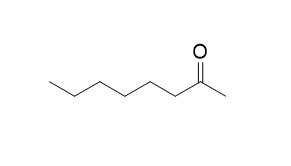2-Octanone
2-Hexanol has neurotoxic potency.
Inquire / Order:
manager@chemfaces.com
Technical Inquiries:
service@chemfaces.com
Tel:
+86-27-84237783
Fax:
+86-27-84254680
Address:
1 Building, No. 83, CheCheng Rd., Wuhan Economic and Technological Development Zone, Wuhan, Hubei 430056, PRC
Providing storage is as stated on the product vial and the vial is kept tightly sealed, the product can be stored for up to
24 months(2-8C).
Wherever possible, you should prepare and use solutions on the same day. However, if you need to make up stock solutions in advance, we recommend that you store the solution as aliquots in tightly sealed vials at -20C. Generally, these will be useable for up to two weeks. Before use, and prior to opening the vial we recommend that you allow your product to equilibrate to room temperature for at least 1 hour.
Need more advice on solubility, usage and handling? Please email to: service@chemfaces.com
The packaging of the product may have turned upside down during transportation, resulting in the natural compounds adhering to the neck or cap of the vial. take the vial out of its packaging and gently shake to let the compounds fall to the bottom of the vial. for liquid products, centrifuge at 200-500 RPM to gather the liquid at the bottom of the vial. try to avoid loss or contamination during handling.
Free Radic Biol Med.2017, 112:191-199
Food Chemistry: X.2022, 2022.100270
Int J Cosmet Sci.2023, 45(2):155-165.
BMC Complement Altern Med.2019, 19(1):367
Evid Based Complement Alternat Med.2018, 2018:3610494
Biology (Basel).2020, 9(11):363.
Int J Mol Sci.2022, 23(21):13406.
Life Sci.2021, 270:119074.
Int J Mol Sci.2018, 19(9):E2825
J Korean Soc Food Sci Nutr2023, 52(7): 750-757
Related and Featured Products
Sangyō igaku. Japanese journal of industrial health, 1982, 24(5):475-484.
An experimental study on the neurotoxicity of 2-octanone and 2-hexanol, a metabolite of n-hexane.[Pubmed:
6296504]
An electrophysiological study of the neurotoxicity of 2-Octanone (an analogue of methyl n-butyl ketone) and 2-hexanol (a metabolite of n-hexane) was conducted on rats as a part of the study to determine the specific molecular arrangement required for the development of peripheral neuropathy.
METHODS AND RESULTS:
The compound 2-Octanone or 2-hexanol was administered subcutaneously in the daily dose of 400 mg/kg of each compound into the back of seven rats, weighing 290 g, 5 days per week for a period of 21 weeks. Animals treated with 2-Octanone for 21 weeks failed to exhibit apparent clinical and neurophysiological evidence except a slight inhibition of weight gain and narcotic effects after treatment with the compound. The same doses of 2-hexanol for 21 weeks caused hypersalivation, gait disturbances, crossing phenomena of hind limbs and a failure of normal growth. Retardation of the conduction velocity in the motor and sensory nerve fibers and the prolonged motor latencies of the tail nerves (distal part) began to appear at the 14th week of the experiment when 9.6 g in the total dose had been given to each animal. These changes were intensified in the subsequent course of the experiment. Our previous experiments and the present results showed that n-hexane barely produced peripheral neuropathy in doses over 10.5 g, and that 2-hexanone (MBK), 2,5-hexanediol or 2,5-hexanedione never failed to produce a neuropathy even in doses less than 9.6 g of each compound.
CONCLUSIONS:
The above results suggest that the neurotoxic potency of 2-hexanol is greater than that of n-hexane but less than that of MBK, 2,5-hexanediol or 2,5-hexanedione.
Ind.eng.chem.res, 2008, 47(6):1774-1778.
Obtaining 2Octanol, 2-Octanone, and Sebacic Acid from Castor Oil by Microwave-Induced Alkali Fusion.[Reference:
WebLink]
METHODS AND RESULTS:
In this study, the effect of microwave irradiation on alkali fusion of castor oil was investigated using different NaOH/oil ratios (8:15, 12:15, and 14:15), reaction temperatures (473, 493, 503, 513, and 523 K), and reaction times (15, 20, 25, and 30 min) in order to obtain oleochemicals (2-octanol, 2-Octanone, and sebacic acid) in the presence of 1% catalyst (Pb3O4) by weight (w/w). The yields of 2-octanol (4.4−62.6%), 2-Octanone (1.6−37.4%), and sebacic acid (9.1−76.2%) were obtained according to reaction conditions.
Maximum yields of oleochemicals were obtained using methylated then presaponified castor oil (sodium ricinoleate), 14/15 NaOH/oil ratio at temperature 513 K and 20 min reaction time. 2-Octanol, 2-Octanone, and sebacic acid were determined by GC and GC/MS analysis, and purity of sebacic acid (98.7%) was further assessed by its acid value (444) and melting point (406.5 K).
CONCLUSIONS:
Reaction time compared to conventional heating was dramatically decreased by microwave heating system from 5 h reaction time to 20 min.
6-Hydroxywogonin
Catalog No: CFN95009
CAS No: 76844-70-7
Price: $368/5mg
Polygalasaponin XLIX
Catalog No: CFN95117
CAS No: 1033593-12-2
Price: $318/10mg
(3S,5S,E)-1,7-Diphenylhept-1-ene-3,5-diol
Catalog No: CFN95195
CAS No: 87095-75-8
Price: $318/5mg
Saucerneol
Catalog No: CFN95267
CAS No: 88497-86-3
Price: $318/5mg
Solafuranone
Catalog No: CFN95312
CAS No: 367965-50-2
Price: $318/5mg
Secotubeimoside I
Catalog No: CFN95347
CAS No: 106235-32-9
Price: $318/10mg
Lariciresinol 4-O-glucoside
Catalog No: CFN95389
CAS No: 143663-00-7
Price: $318/5mg
12beta-Acetoxy-3beta-hydroxy-7,11,15,23-tetraoxo-lanost-8,20-diene-26-oic acid
Catalog No: CFN95468
CAS No: 1085338-75-5
Price: $318/5mg
2,6-Dihydroxyacetophenone-4-O-[4',6'-(S)-hexahydroxydiphenoyl]-beta-D-glucose
Catalog No: CFN95470
CAS No: 1781226-44-5
Price: $318/5mg
Nomilinic acid
Catalog No: CFN95559
CAS No: 35930-20-2
Price: $318/5mg



